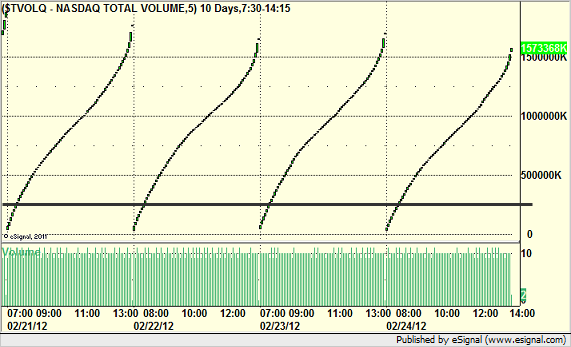One of the most important keys to success in trading is volume. When the market is trading average volume or better, things happen. Technical triggers and technical behavior work. It’s easier to make money. When the market doesn’t trade good volume, things are less likely to work.
One of the things that we teach is that traders need to recognize days that are likely to be light on volume, such as Holidays, Holiday weeks (Christmas, etc.), summer break, and more. During those periods, less people are trading, which means fewer trades are likely to find the support of traders and the “counter” players such as market makers and banks will stop trades from working.
Success in trading is about doing the high probability things at the points where they are the most likely to work. Without volume, they are less likely to work.
For years, we measured volume in a simple way. If the NASDAQ volume after 30 minutes was over 250 million shares and after 60 minutes was over 450 million shares, then you had at least an average volume day or better. That increased your odds of success. Now, the same rules apply. A few weeks ago, we had five days of above average volume and tons of trade triggers and most of them worked. Compare that to this last week, where we had light volume, two good trading days, one that was unexciting, and one where volume was so bad that I didn’t even trade.
However, the point of this article isn’t that trading is better with volume. We already know that. The point that I want to make here is that in this year, 2012, we’ve seen volume play out a little differently, and traders should take note.
It used to be that if volume was around 250 million on the NASDAQ after 30 minutes, it would probably be fairly close (plus or minus) 450 million after 60 minutes, and that was good for trading. That would take us somewhere near a 2 billion share day. So the idea was that if volume was over 250 million on the NASDAQ after 30, you would probably get confirmation of good volume by seeing a reading over 450 million after 60, and that would put you over 2 billion shares for the session, which increased the odds that our trades would work.
This has changed recently.
The difference lately is that we have actually seen several days where volume is close to 250 million early, but comes in nowhere near the 450 million share mark after 60 minutes. We then end up way short of our 2 billion shares for the day mark. This means that checking volume after 30 minutes isn’t representative enough of what we need to know. The 60 minute check is more important.
Here’s the last week (Monday was a Holiday, so Tuesday through Friday) in NASDAQ volume:

I’ve drawn a black line at 250 million shares. So after 30 minutes those four days, we were at 246, 223, 243, and 204 million shares. Three of those numbers are solid number, but we never got above 1.8 billion shares for any day of the week by the close.
In fact, the 60 minute checks were: 402, 386, 410, and 350 million. We consider anything under 400 million shares after an hour a “volume warning,” which means that the number is so bad, traders should be concerned. But here we are with three days during the week that looked fine after 30 minutes, but those same three days saw 402 (barely over the minimum for a warning), 386 (a warning), and 410 (best of the week and barely over the minimum). Friday was so awful that I dubbed it “XMAS VOLUME WARNING” after 60 minutes because we were only at 350 million, which is horrible.
Something has changed. What this means is that even if we get a “retail push” for market open, it doesn’t last past the first 30 minutes. What does this mean for trading? Is this the new norm?
No, it isn’t. When you look at the markets today, you’ve got the Yen not moving (until the last week) since the earthquake, you have the Euro in trouble due to the situation in Greece and beyond, you have the US Dollar in trouble since the downgrade of our debt since we couldn’t make an attempt to balance our long-term budget, and you have too much wealth in the hands of too few. There is a consequence for all of these issues, which is that the rich can’t make the market active on their own.
Volume requires participants, not just a handful of people with a bunch of money. When we see activity drop off as we have, we have to understand that there are broader implications. Will it last? No, markets come and go in terms of excitement and activity. Long-term traders (meaning people that make it in this industry, not people that buy and hold) understand that when volume isn’t what you want to see, you have to back off. You can’t force things to happen when they aren’t there and aren’t going to work.
Volume is critical, and the fact that we are seeing this strange behavior of near-decent volume after 30 but nowhere-near-decent volume after 60 minutes should be a lesson for professional traders not to overtrade and kill themselves until things normalize.
Have a good weekend.
